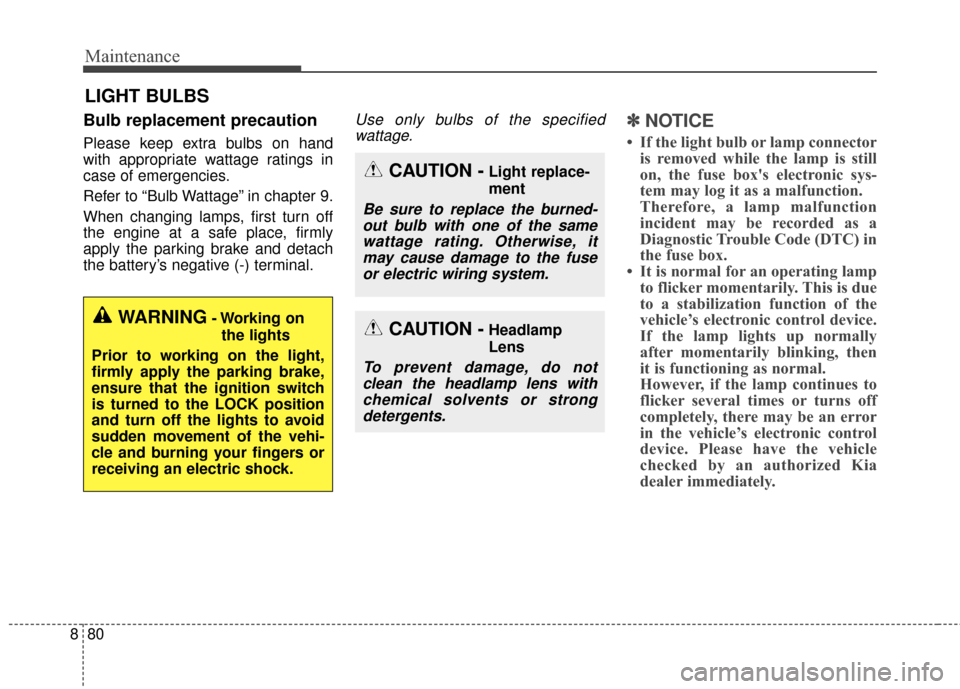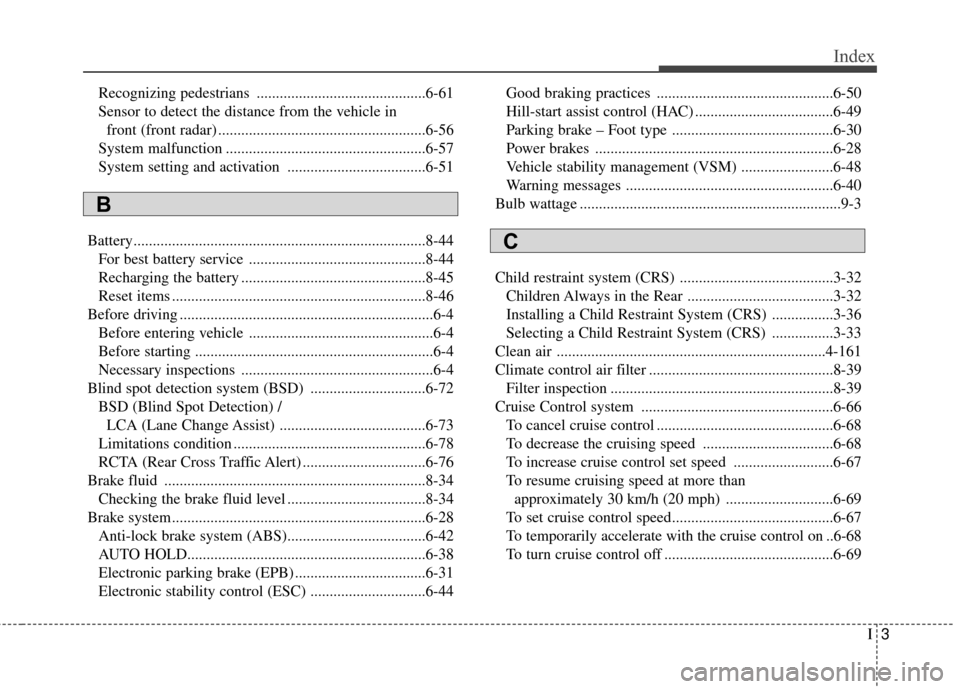2017 KIA Sportage wattage
[x] Cancel search: wattagePage 180 of 595

495
Features of your vehicle
Turn on FUSE SWITCH
This warning message illuminatesif the fuse switch on the fuse box is
OFF.
It means that you should turn the fuse switch on.
For more details, refer to “Fuses” in
chapter 8.
Low Fuel
This warning message illuminates if
the fuel tank is nearly empty.
- When the low fuel level warning light is illuminated.
- When the trip computer displays “--- km (or mile)” as range.
Add fuel as soon as possible.
Check headlight
This warning message illuminates if
there is a malfunction (burned-out
bulb except LED lamp or circuit mal-
function) with the headlamp. In this
case, have your vehicle inspected by
an authorized Kia dealer.
✽ ✽ NOTICE
• When replacing the bulb, use the
same wattage bulb.
For more information, refer to
“BULB WATTAGE” in chapter 9.
• If different wattage bulb is equipped with the vehicle, this
warning message is not displayed.
OQLE045209OQLE045211OQLE045133
Page 210 of 595

4125
Features of your vehicle
Check headlight
This warning message illuminates if
there is a malfunction (burned-out
bulb except LED lamp or circuit mal-
function) with the headlamp. In this
case, have your vehicle inspected by
an authorized Kia dealer.
✽ ✽NOTICE
• When replacing the bulb, use the
same wattage bulb.
For more information, refer to
“BULB WATTAGE” in chapter 8.
• If the different wattage bulb is equipped with the vehicle, this
warning message is not displayed.
AFLS (Adaptive Front Lighting
System) (if equipped)
Adaptive front lighting system uses
the steering angle and vehicle
speed, to keep your field of vision
wide by swiveling and leveling the
headlamp.
Change the switch to the AUTO posi-
tion when the engine is running. The
adaptive front lighting system will
operate when the headlamp is ON.
To turn off the AFLS, change the
switch to other positions. After turn-
ing the AFLS off, headlamp swiveling
no longer occurs, but leveling oper-
ates continuously. If the AFLS malfunction indicator
comes on, the AFLS is not working
properly. Drive to the nearest safe
location and restart the engine. If the
indicator continuously remains on,
have system be checked by an
authorized Kia dealer.
OQL045405
OQLA055176
Page 548 of 595

Maintenance
80
8
LIGHT BULBS
Bulb replacement precaution
Please keep extra bulbs on hand
with appropriate wattage ratings in
case of emergencies.
Refer to “Bulb Wattage” in chapter 9.
When changing lamps, first turn off
the engine at a safe place, firmly
apply the parking brake and detach
the battery’s negative (-) terminal.
Use only bulbs of the specified
wattage.✽ ✽ NOTICE
• If the light bulb or lamp connector
is removed while the lamp is still
on, the fuse box's electronic sys-
tem may log it as a malfunction.
Therefore, a lamp malfunction
incident may be recorded as a
Diagnostic Trouble Code (DTC) in
the fuse box.
• It is normal for an operating lamp to flicker momentarily. This is due
to a stabilization function of the
vehicle’s electronic control device.
If the lamp lights up normally
after momentarily blinking, then
it is functioning as normal.
However, if the lamp continues to
flicker several times or turns off
completely, there may be an error
in the vehicle’s electronic control
device. Please have the vehicle
checked by an authorized Kia
dealer immediately.
WARNING- Working on
the lights
Prior to working on the light,
firmly apply the parking brake,
ensure that the ignition switch
is turned to the LOCK position
and turn off the lights to avoid
sudden movement of the vehi-
cle and burning your fingers or
receiving an electric shock.
CAUTION -Light replace-
ment
Be sure to replace the burned- out bulb with one of the samewattage rating. Otherwise, itmay cause damage to the fuseor electric wiring system.
CAUTION -Headlamp
Lens
To prevent damage, do notclean the headlamp lens withchemical solvents or strongdetergents.
Page 575 of 595

Specifications & Consumer information
Dimensions . . . . . . . . . . . . . . . . . . . . . . . . . . . . . . . . 9-2
Engine . . . . . . . . . . . . . . . . . . . . . . . . . . . . . . . . . . . . \
9-2
Bulb wattage . . . . . . . . . . . . . . . . . . . . . . . . . . . . . . . 9-3
Tires and wheels . . . . . . . . . . . . . . . . . . . . . . . . . . . . 9-4
Gross vehicle weight. . . . . . . . . . . . . . . . . . . . . . . . . 9-6
Luggage volume . . . . . . . . . . . . . . . . . . . . . . . . . . . . 9-6
Air conditioning system . . . . . . . . . . . . . . . . . . . . . . 9-6
Recommended lubricants and capacities . . . . . . . . 9-7
• Recommended SAE viscosity number. . . . . . . . . . . . . 9-9
Vehicle identification number (VIN) . . . . . . . . . . 9-10
Vehicle certification label. . . . . . . . . . . . . . . . . . . . 9-10
Tire specification and pressure label . . . . . . . . . . 9-11
Engine number . . . . . . . . . . . . . . . . . . . . . . . . . . . . 9-11
9
Page 577 of 595

93
BULB WATTAGESpecifications & Consumer information
Light Bulb
Wattage (W) Bulb type
Front Headlamps (Low)
609005HL+
Headlamps (Low) - HID type* 34D3S
Headlamps (High) 609005HL+
Front turn signal lamps 28PY28/8W
Front position lamps Bulb type 5
W5W
LED type LED LED
Daytime running light Bulb type 28
P28/8W
LED typeLEDLED
Front fog lampsBulb type519006
LED typeLEDLED
Rear Rear Stop/Tail lamps (outside)
Bulb type28/8 P28/8W
Rear tail lamps (Inside) 8 P28/8W
Rear Stop/Tail lamps (outside) LED typeLED LED
Rear tail lamps (Inside) LED LED
Rear turn signal lamps 27 PY27W
Back-up lamps 21 P21W
High mounted stop lamp* LED LED
License plate lamps 5 W5W
Interior Map lamps 10 (LED) W10W (LED)
Room lamps 10 FESTOON
Vanity mirror lamps 5 FESTOON
Glove box lamp 5 FESTOON
Trunk lamp 10 (LED) FESTOON (LED)
* : if equipped
Page 588 of 595

I3
Index
Recognizing pedestrians ............................................6-61
Sensor to detect the distance from the vehicle in front (front radar) ......................................................6-56
System malfunction ....................................................6-57
System setting and activation ....................................6-51
Battery........................................................................\
....8-44 For best battery service ..............................................8-44
Recharging the battery ................................................8-45
Reset items ..................................................................8-46
Before driving ..................................................................6-4 Before entering vehicle ................................................6-4
Before starting ........................................................\
......6-4
Necessary inspections ..................................................6-4
Blind spot detection system (BSD) ..............................6-72 BSD (Blind Spot Detection) /LCA (Lane Change Assist) ......................................6-73
Limitations condition ..................................................6-78
RCTA (Rear Cross Traffic Alert) ................................6-76
Brake fluid ....................................................................8-34\
Checking the brake fluid level ....................................8-34
Brake system..................................................................6-28 Anti-lock brake system (ABS)....................................6-42
AUTO HOLD..............................................................6-38
Electronic parking brake (EPB) ..................................6-31
Electronic stability control (ESC) ..............................6-44 Good braking practices ..............................................6-50
Hill-start assist control (HAC) ....................................6-49
Parking brake – Foot type ..........................................6-30
Power brakes ..............................................................6-28
Vehicle stability management (VSM) ........................6-48
Warning messages ......................................................6-40
Bulb wattage ....................................................................9-3
Child restraint system (CRS) ........................................3-32 Children Always in the Rear ......................................3-32
Installing a Child Restraint System (CRS) ................3-36
Selecting a Child Restraint System (CRS) ................3-33
Clean air ......................................................................4-\
161
Climate control air filter ................................................8-39 Filter inspection ..........................................................8-39
Cruise Control system ..................................................6-66 To cancel cruise control ..............................................6-68
To decrease the cruising speed ..................................6-68
To increase cruise control set speed ..........................6-67
To resume cruising speed at more than approximately 30 km/h (20 mph) ............................6-69
To set cruise control speed..........................................6-67
To temporarily accelerate with the cruise control on ..6-68
To turn cruise control off ............................................6-69
B
C